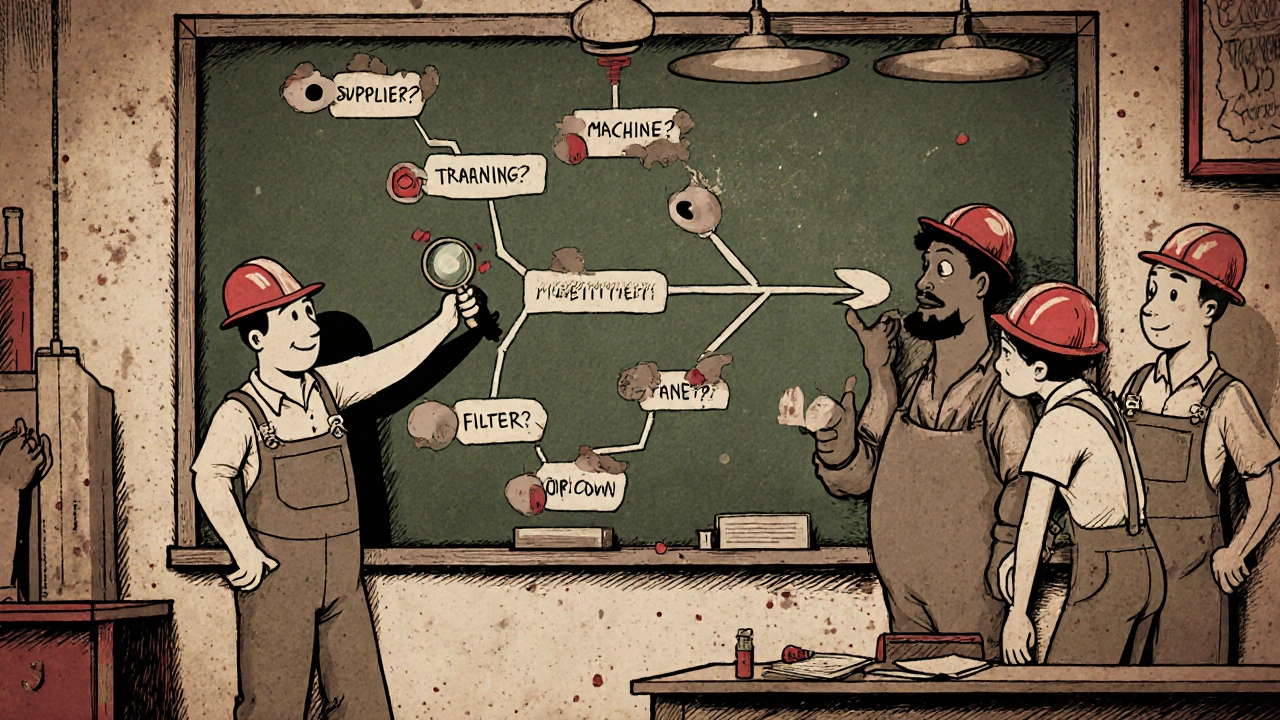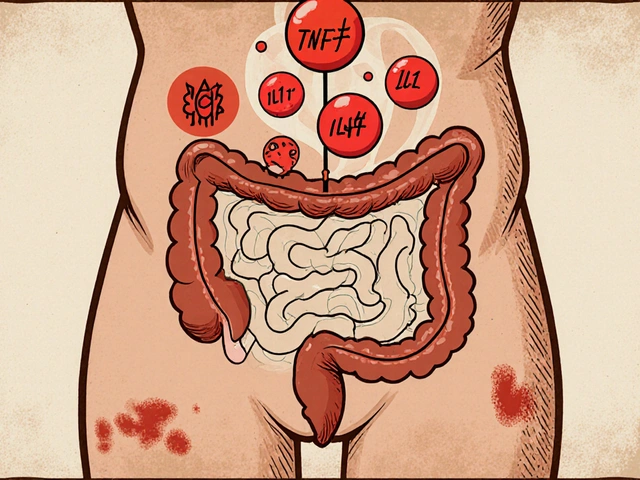What Exactly Is a Corrective Action?
When a product leaves the factory with a defect, most people think the fix is simple: throw out the bad parts and make more. But that’s just a correction. A corrective action is something deeper. It’s about asking: Why did this happen in the first place? And then making sure it never happens again.
Manufacturers don’t just fix symptoms-they hunt down the root cause. Maybe a machine was misaligned. Maybe a worker wasn’t trained properly. Maybe the supplier sent bad raw material. Corrective actions target those hidden problems, not the visible ones.
It’s not optional in regulated industries. If you make medical devices, pharmaceuticals, or automotive parts, you’re legally required to have a system called CAPA-Corrective and Preventive Action. The FDA, ISO, and other regulators demand documented proof that you’re not just patching issues, but truly eliminating them.
The Six-Step Process Manufacturers Actually Use
There’s no magic formula, but every successful manufacturer follows the same six steps. Here’s how it works in real factories:
- Identify the problem - It starts with a defect report, a customer complaint, or a machine alert. Quality teams log every issue, no matter how small. Even one broken screw out of 10,000 gets tracked.
- Evaluate and categorize - Not all problems are equal. Is this a safety risk? A regulatory violation? Or just a cosmetic flaw? High-risk issues get priority. A cracked medical implant? Immediate action. A slightly off-color label? Lower priority.
- Find the root cause - This is where most companies fail. Too many jump to conclusions: “The operator messed up.” But that’s not a root cause. That’s a symptom. Experts use tools like the 5 Whys or Fishbone diagrams. Why did the screw break? Because torque was too high. Why was torque too high? Because the calibration drifted. Why did it drift? Because the maintenance schedule skipped quarterly checks. Now you’ve found it.
- Plan the fix - The solution must be specific. Not “train the team.” But “retrain all assembly line workers on torque calibration by Friday, using the updated SOP version 3.2, and verify with 30 random torque tests.” Assign names. Set deadlines. Define how you’ll prove it worked.
- Implement and document - Changes get locked in. New procedures are uploaded to the digital work instructions. Machines get recalibrated. Tools are replaced. Every step is recorded. Paper trails aren’t bureaucracy-they’re legal protection.
- Verify effectiveness - Did the fix actually work? You can’t assume. You test. Run 300 units after the fix. Check defect rates. Compare before and after. If the defect rate doesn’t drop by at least 50% over three production cycles, you haven’t solved it yet.
Why Most Corrective Actions Fail
Here’s the hard truth: 61% of companies inspected by the FDA in 2022 failed their corrective action audits-not because they didn’t try, but because they treated symptoms like solutions.
Common failures:
- Blaming people instead of processes
- Skipping root cause analysis and going straight to “retrain”
- Not verifying results-just assuming the fix worked
- Letting paperwork pile up without action
One automotive supplier had a recurring issue with brake calipers leaking. They kept replacing seals. The defect rate stayed at 1.8%. Then they dug deeper. Turns out, the hydraulic fluid was being contaminated because a new filter supplier used cheaper material. Fixing the seal wasn’t the answer. Fixing the supplier was.
Another company spent six months on a CAPA for a mislabeled product. They changed the label design, retrained staff, updated software. But the problem kept coming back. Why? Because the root cause was a misconfigured barcode scanner that didn’t read the new label format. No one checked the machine.

Corrective vs. Preventive vs. Correction
People mix these up all the time. Here’s how they’re different:
| Type | Goal | When It’s Used | Documentation Level |
|---|---|---|---|
| Correction | Fix the immediate problem | Stopping a line, throwing out bad parts, adjusting a setting | Low - often just a log entry |
| Corrective Action | Eliminate the cause of an existing problem | After a defect is found and tracked over time | High - full CAPA file with root cause, plan, verification |
| Preventive Action | Stop a problem before it happens | When trends show a risk (e.g., 3 near-misses in a week) | Medium - less formal than CAPA but still documented |
Confusing them is expensive. A 2023 study found that 68% of quality failures came from treating a correction like a corrective action. You can’t fix a broken process by just replacing parts.
What Works: Real Success Stories
Manufacturers who get it right see real results:
- An orthopedic device maker cut field returns by 27% after implementing a digital CAPA system that linked defect data directly to production machines.
- A pharmaceutical plant reduced audit findings by 34% by assigning single-point accountability-each CAPA had one owner, not a committee.
- An automotive supplier slashed defect rates from 2.8% to 0.4% in 18 months by using AI to flag anomalies in real-time and auto-generate CAPA triggers.
The common thread? They didn’t just add paperwork. They built systems that made it easier to find problems early and fix them fast.
One plant in Ohio used to spend 12 hours per CAPA just filling out forms. After switching to a digital platform integrated with their ERP system, that dropped to 7 hours-with better tracking and faster approvals.
The Hidden Cost of Doing Nothing
Skipping real corrective actions might save time today-but it costs way more tomorrow.
Here’s what happens when you ignore root causes:
- Repeated defects → higher scrap and rework costs
- Customer complaints → lost trust and sales
- Regulatory warnings → fines, production halts, recalls
- Employee frustration → turnover, lower morale
Manufacturers with strong CAPA systems see:
- 37% less downtime from quality issues
- 28% higher customer satisfaction scores
- 19% lower operational costs from reduced waste
That’s not theory. That’s data from 157 medical device and pharma firms tracked by Cognidox in 2023.

What’s Changing in 2025
Regulations and tech are pushing CAPA into the future.
The FDA’s new QMSR rules (effective 2024) now require manufacturers to prove effectiveness-not just document effort. You can’t just say “we fixed it.” You have to show data that it stayed fixed.
AI is changing root cause analysis. Instead of waiting for a defect to be reported, systems now flag anomalies in real time-like a machine vibration pattern that predicts a bearing failure before it happens. One pilot plant reduced investigation time by 52% using machine learning to correlate sensor data with past CAPAs.
Blockchain-based audit trails are starting to appear in high-risk industries. Every change to a CAPA document is timestamped and locked. No backdating. No deletions. Just clear, tamper-proof records.
By 2027, Gartner predicts 65% of manufacturers will use predictive CAPA-systems that trigger fixes before defects even occur.
How to Start Getting It Right
If your factory still treats corrections like corrective actions, here’s where to begin:
- Choose one recurring problem. Not the biggest one-the one you’ve seen at least three times.
- Form a small team: production lead, quality engineer, maintenance tech, and one operator.
- Use the 5 Whys. Write down each answer. Don’t stop until you hit a process, not a person.
- Write a plan with names, dates, and how you’ll measure success.
- Run 50 units after the fix. Compare defect rates to the last 50 before.
- Document everything-even if you think it’s obvious.
You don’t need fancy software. You need discipline. And you need to stop accepting “it’s just human error” as an answer.
What Happens If You Don’t Fix the Root Cause?
One medical device company ignored a small leak in a glucose monitor. They replaced the seal each time. No one dug deeper. Six months later, 12 patients had infections. The device was recalled. The company paid $22 million in fines and lawsuits. Their brand never recovered.
Corrective actions aren’t about avoiding blame. They’re about protecting people. And protecting your business.
What’s the difference between a correction and a corrective action?
A correction fixes the immediate problem-like pulling a defective part off the line. A corrective action finds and eliminates the root cause so the problem doesn’t happen again. Corrections are quick fixes. Corrective actions are permanent fixes.
Do all manufacturers need a CAPA system?
If you’re in a regulated industry-medical devices, pharmaceuticals, aerospace, or automotive-you’re legally required to have a CAPA system. For other manufacturers, it’s not mandatory, but companies without one see higher defect rates, more recalls, and lower customer trust. CAPA is a competitive advantage.
How long should a corrective action take?
There’s no fixed timeline, but the root cause analysis should never take more than two weeks for most issues. If it’s taking months, you’re likely overcomplicating it. The key isn’t speed-it’s accuracy. A 30-day CAPA that works is better than a 3-day one that fails.
Why do CAPA systems generate so much paperwork?
Regulators require proof that you didn’t just guess-you investigated, planned, tested, and verified. Paperwork is the evidence. But digital tools now reduce this by 40% or more. The goal isn’t to create documents-it’s to create reliable systems. If your CAPA feels like a paperwork nightmare, it’s time to upgrade your software.
Can AI really help with corrective actions?
Yes. AI can analyze real-time sensor data from machines and flag patterns that humans miss. It can link past defects to current anomalies and suggest root causes. One manufacturer reduced investigation time by over half using AI to auto-generate CAPA suggestions. It doesn’t replace people-it helps them work faster and smarter.





